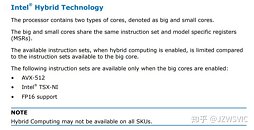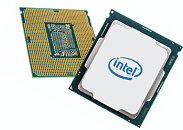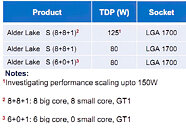
Intel "Alder Lake" CPU Core Segmentation Sketched
Intel's 12th Gen Core "Alder Lake-S" desktop processors in the LGA1700 package could see the desktop debut of Intel's Hybrid Technology that it introduced with the mobile segment "Lakefield" processor. Analogous to Arm big.LITTLE, Intel Hybrid Technology is a multi-core processor topology that sees the combination of high-performance CPU cores with smaller high-efficiency cores that keep the PC ticking through the vast majority of the time/tasks when the high-performance cores aren't needed and hence power-gated. The high-performance cores are woken up only as needed. "Lakefield" combines one "Sunny Cove" high-performance core with four "Tremont" low-power cores. "Alder Lake-S" will take this concept further.
According to Intel slides leaked to the web by HXL (aka @9550pro), the 10 nm-class "Alder Lake-S" silicon will physically feature 8 "Golden Cove" high-performance cores, and 8 "Gracemont" low-power cores, along with a Gen12 iGPU that comes in three tiers - GT0 (iGPU disabled), GT1 (some execution units disabled), and GT2 (all execution units enabled). In its top trim with 125 W TDP, "Alder Lake-S" will be a "16-core" processor with 8 each of "Golden Cove" and "Gracemont" cores enabled. There will be 80 W TDP models with the same 8+8 core configuration, which are probably "locked" parts. Lastly, there the lower wrungs of the product stack will completely lack "small" cores, and be 6+0, with only high-performance cores. A recurring theme with all parts is the GT1 trim of the Gen12 iGPU.
According to Intel slides leaked to the web by HXL (aka @9550pro), the 10 nm-class "Alder Lake-S" silicon will physically feature 8 "Golden Cove" high-performance cores, and 8 "Gracemont" low-power cores, along with a Gen12 iGPU that comes in three tiers - GT0 (iGPU disabled), GT1 (some execution units disabled), and GT2 (all execution units enabled). In its top trim with 125 W TDP, "Alder Lake-S" will be a "16-core" processor with 8 each of "Golden Cove" and "Gracemont" cores enabled. There will be 80 W TDP models with the same 8+8 core configuration, which are probably "locked" parts. Lastly, there the lower wrungs of the product stack will completely lack "small" cores, and be 6+0, with only high-performance cores. A recurring theme with all parts is the GT1 trim of the Gen12 iGPU.








